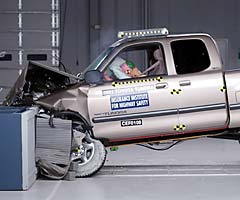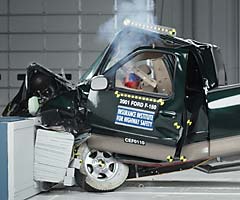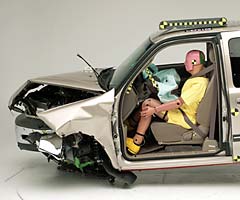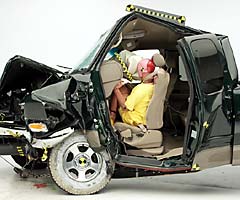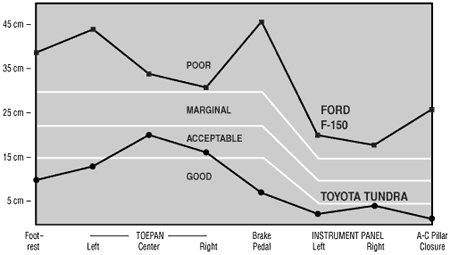Little intrusion into the Tundra; dummy's movement was controlled: The Toyota Tundra's structure performed well in the offset test. "There was very little intrusion into the occupant compartment, very little deformation. As a result, the dummy's movement was well controlled, and the injury measures all were low except for some moderately high forces recorded on the dummy's right leg," Institute president Brian O'Neill says. Ford F-150 is worst: In contrast, the F-150 "exhibited major collapse of the occupant compartment in the offset test," O'Neill points out. "As a result of this collapse, the dummy's movement wasn't well controlled. High injury measures were recorded on the dummy's head and neck. The airbag deployed late in the crash, and this also contributed to the high injury measures." The appearance of the F-150 compared with the Tundra after the offset test provides a dramatic contrast, showing the very different performances of these vehicles' structures. The F-150's occupant compartment was destroyed, while the Tundra's doors still functioned.
The contrast also is apparent in measurements of occupant compartment intrusion into the two vehicles. To quantify performance, Institute engineers take 8 measurements of intrusion around the driver. They also measure steering column movement. Low measurements indicate that a vehicle's crumple zone and safety cage are well designed. All 10 measurements are dramatically better in the Tundra compared with the F-150: MEASUREMENTS
OF OCCUPANT COMPARTMENT INTRUSION
COMPARISON
OF INTRUSION INTO TOYOTA TUNDRA
"A key aspect of protecting people in crashes is keeping the space around occupants intact. Then the safety belts and airbags can prevent significant injuries, even in very serious crashes. This is what happened in the Tundra but not in the F-150," O'Neill says. Performance of Chevrolet Silverado: This large pickup is rated marginal. Injury measures were good, but there was substantial occupant compartment intrusion, and dummy movement wasn't controlled during the offset test. Performance of Dodge Ram: This large pickup is rated poor. There was significant intrusion into the occupant compartment and poor control of dummy movement during the offset crash test. As in the F-150, the airbag deployed late, which contributed to high head and neck injury measures. Institute and government crash tests complement each other: The Institute's crashworthiness evaluations are based primarily on results of the frontal offset crash test at 40 mph. Each vehicle's overall evaluation is based on three aspects of performance -- measurements of occupant compartment intrusion, injury measures from a Hybrid III dummy positioned in the driver seat, and analysis of slow-motion film to assess how well the restraint system controlled dummy movement during the test. The federal government has been crash testing new passenger vehicles in 35 mph impacts since 1978. This New Car Assessment Program has been a major contributor to crashworthiness improvements -- in particular, improved restraint systems -- in new passenger vehicles. The Institute's offset tests, conducted since 1995, involve 40 percent of a vehicle's front end hitting a deformable barrier at 40 mph. This test complements the federal test involving the full width of the front end hitting a rigid barrier. Full-width tests are especially demanding of restraints but less demanding of structure, while the reverse is true in offsets. The same 40 mph offset crash test is used to evaluate new cars by the European Union in cooperation with motor clubs and by an Australian consortium of state governments and motor clubs.
©2001, Insurance Institute for Highway Safety, Highway Loss Data Institute |
|||||||||||||||||||||||||||||||||||||||||||||||||||||

